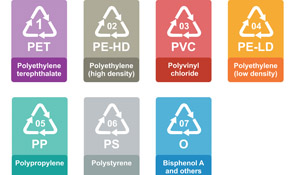
Plastics are everywhere. They can be found in our homes, wrapped around our foods, and even in our cosmetics. And recently phthalates, a group of chemicals used to make plastics more pliable, have been the subject of scrutiny about potential health risks to consumers.
Where Phthalates Are Found
Phthalates can be found just about anywhere, according to the Centers of Disease Control and Prevention (CDC); the chemicals may be present in "vinyl flooring, adhesives, detergents, lubricating oils, automotive plastics, plastic clothes (raincoats), and personal-care products." In addition to household products, the National Institutes for Health (NIH) reports that many children’s toys and goods produced before 1999 may also contain phthalates.
So, What’s the Problem?
Because phthalates are so common in our society, our bodies are exposed to the chemicals regularly. Most phthalates, once they enter the body, are processed, broken down, and forced out through urine.
Certain phthalates have raised concerns: Di(2-ethylhexyl) phthalate (DEHP), an odorless chemical found in a variety of household products, is one of them. While "DEHP is not expected to cause harmful health effects in humans," according to the Agency for Toxic Substances & Disease Registry (ATSDR), it does note that DEHP has been found to cause reproductive issues in lab mice. Moreover, it is "reasonably anticipated to be a human carcinogen [cancer-causing agent]" by the National Toxicology Program.
Most government agencies, including the CDC and NIH, admit that the effects of phthalate exposure are largely unknown. Still, in 2008 Congress outlawed the use of three types of phthalates, including DEHP, in amounts greater than 0.1 percent in children’s products.
Playing it Safe
Since the jury is still out on the safety of phthalates, it’s hard to determine just what steps to take to ensure your safety. But if you’re concerned about exposure to these chemicals, the Natural Resources Defense Council recommends the following:
- Buy phthalate-free products. While companies are not required to list if phthalates are used in their goods, some manufacturers have pledged not to use them. Seek these companies out.
- Avoid phthalate-treated products. Goods treated with phthalates typically will have a "PVC," "V," or "3" recycling code on the packaging. Check the packaging of the product before buying it.
- Mind your floors. Phthalates can be found in a variety of flooring materials, which, in turn, can cause the chemicals to be released into the air. Mop your floors regularly, as phthalates can bind to dust particles. Additionally, you may want to replace your flooring with non-phthalate materials such as wood, stone, or cork.
Rafael, Pajaro, MD, reviewed this article.
Sources
"Toxic Substances Portal - Di(2-ethylhexyl)phthalate (DEHP)." Agency for Toxic Substances & Disease Registry. Page last updated October 21, 2011.
"Phthalate Factsheet." Centers for Disease Control and Prevention. National Biomonitoring Program. Page last updated July 16, 2013.
"FAQs: Bans on Phthalates in Children's Toys." Consumer Product Safety Commission. Page last updated November 15, 2011.
"Phthalates." National Institutes for Health. Tox Town. Page last updated April 22, 2014.
"Phthalates." Natural Resources Defense Council. Page last revised December 28, 2011.
"Check the Kind of Plastics You Use." Pediatric Environmental Health Specialty Units. Updated October 2009. h





